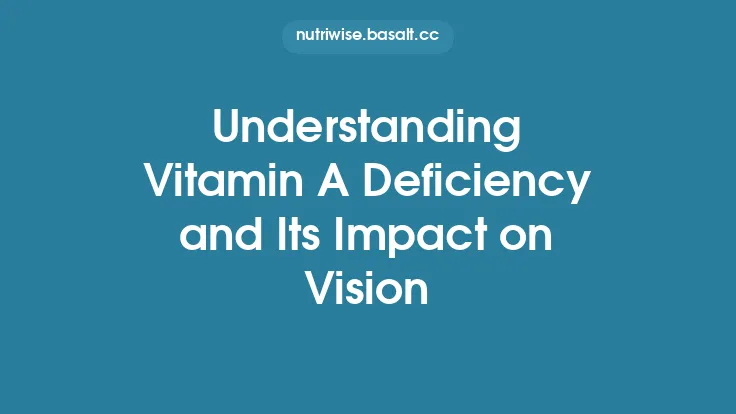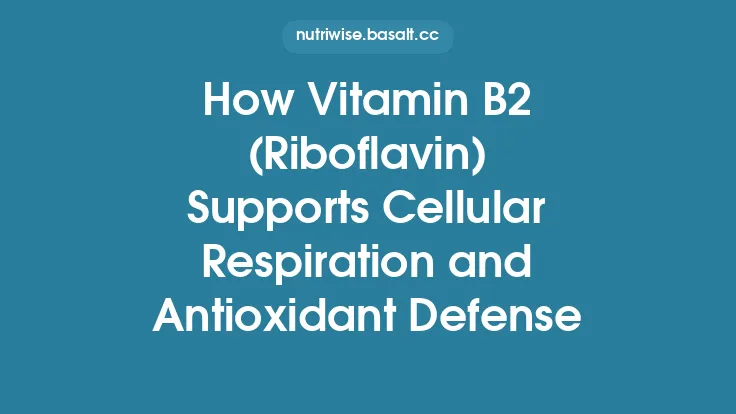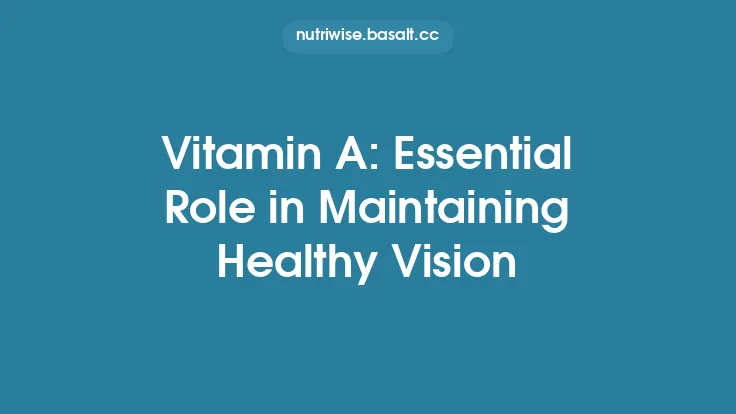Night vision is one of the most remarkable capabilities of the human eye, allowing us to navigate dimly lit environments with a level of detail that far exceeds what our cones can provide. At the heart of this ability lies a single micronutrient—vitamin A. While many people associate vitamin A with overall eye health, its specific role in the visual processes that dominate low‑light conditions is both unique and critical. This article explores the intricate ways vitamin A supports night vision, the biochemical pathways that link the nutrient to the photoreceptor cells responsible for scotopic (low‑light) vision, and practical strategies for preventing night blindness (nyctalopia) through adequate intake and lifestyle choices.
The Physiology of Night Vision
The retina contains two primary types of photoreceptor cells: cones, which mediate color and high‑acuity vision under bright light, and rods, which dominate under dim illumination. Rods are far more numerous—approximately 120 million in the human retina compared with 6 million cones—and are exquisitely sensitive to single photons. This heightened sensitivity is largely due to the presence of a specialized visual pigment called rhodopsin, which is embedded in the disc membranes of rod outer segments.
Rhodopsin’s ability to capture photons at low light intensities hinges on its molecular configuration. In its resting state, rhodopsin consists of the protein opsin covalently bound to a chromophore derived from vitamin A: 11‑cis‑retinal. When a photon strikes rhodopsin, 11‑cis‑retinal undergoes an ultrafast isomerization to all‑trans‑retinal, triggering a cascade of intracellular events that ultimately generate an electrical signal transmitted to the brain. The speed and efficiency of this cascade enable rods to respond to minimal light, forming the basis of night vision.
Rhodopsin: The Light‑Sensitive Pigment of Rod Cells
Rhodopsin is a G‑protein‑coupled receptor (GPCR) that operates through a well‑characterized phototransduction pathway:
- Photon Absorption – A photon of light is absorbed by 11‑cis‑retinal, causing it to convert to all‑trans‑retinal.
- Conformational Change – This isomerization induces a structural shift in opsin, activating the G‑protein transducin.
- Signal Amplification – Activated transducin stimulates phosphodiesterase (PDE), which hydrolyzes cyclic GMP (cGMP). The drop in cGMP closes cGMP‑gated Na⁺/Ca²⁺ channels, hyperpolarizing the rod cell.
- Neurotransmitter Release – Hyperpolarization reduces the release of glutamate at the synapse with bipolar cells, ultimately modulating the firing of retinal ganglion cells and sending a visual signal to the brain.
The regeneration of rhodopsin after photon capture is essential for sustained night vision. Without a rapid supply of fresh 11‑cis‑retinal, the photoreceptor’s ability to respond to subsequent photons diminishes, leading to a temporary decline in visual sensitivity.
The Biochemical Cycle Linking Vitamin A to Rhodopsin Regeneration
The visual cycle is a series of enzymatic steps that recycle all‑trans‑retinal back to 11‑cis‑retinal, ensuring a continuous supply of the chromophore. Vitamin A enters this cycle in the form of retinol (the alcohol) or retinyl esters stored in the retinal pigment epithelium (RPE). The key stages are:
- Reduction of All‑trans‑Retinal to All‑trans‑Retinol – In the rod outer segment, all‑trans‑retinal is reduced by NADPH‑dependent retinol dehydrogenase (RDH) to all‑trans‑retinol.
- Transport to the RPE – All‑trans‑retinol diffuses or is shuttled via interphotoreceptor retinoid‑binding protein (IRBP) to the adjacent RPE cells.
- Esterification and Storage – Within the RPE, all‑trans‑retinol is esterified by lecithin‑retinol acyltransferase (LRAT) to form retinyl esters, which serve as a reservoir.
- Isomerization to 11‑cis‑Retinol – The enzyme RPE65 catalyzes the isomerization of retinyl esters to 11‑cis‑retinol.
- Oxidation to 11‑cis‑Retinal – 11‑cis‑retinol is oxidized by 11‑cis‑retinol dehydrogenase (RDH5) to produce 11‑cis‑retinal.
- Rebinding to Opsin – 11‑cis‑retinal returns to the rod outer segment, where it recombines with opsin to reform rhodopsin, ready for another photon capture.
Each step depends on the availability of vitamin A‑derived substrates and on the functional integrity of the enzymes involved. A deficiency in vitamin A reduces the pool of retinol and retinyl esters, slowing the regeneration of 11‑cis‑retinal and consequently impairing rhodopsin replenishment. The result is a measurable decline in scotopic sensitivity, manifesting clinically as night blindness.
How Vitamin A Deficiency Disrupts Night Vision
When dietary intake of vitamin A falls below the body’s requirements, several physiological changes occur:
- Depleted Retinol Stores – Liver reserves, the primary storage site for vitamin A, become exhausted, limiting the substrate available for the visual cycle.
- Reduced Rhodopsin Concentration – Lower levels of 11‑cis‑retinal lead to a decrease in functional rhodopsin molecules within rod outer segments.
- Prolonged Photoreceptor Recovery – The time required for rhodopsin regeneration lengthens, causing a delayed return to baseline sensitivity after exposure to light.
- Altered Phototransduction Kinetics – Insufficient chromophore can affect the amplitude and speed of the electrical response generated by rods, reducing overall signal strength.
These biochemical deficits translate into the hallmark symptom of nyctalopia: difficulty seeing in dim light, often described as a “halo” or “glare” around lights, and a need for prolonged adaptation periods when moving from bright to dark environments.
Clinical Presentation of Night Blindness (Nyctalopia)
Nyctalopia is not a disease in itself but a clinical sign that can arise from several etiologies, with vitamin A deficiency being a classic cause in populations with limited dietary access to retinoids. Typical features include:
- Delayed Dark Adaptation – Patients may require 20–30 minutes (or longer) to achieve full visual acuity after entering a dark room, compared with the normal 5–10 minutes.
- Reduced Visual Acuity in Low Light – Even when adapted, individuals often report blurred or “washed‑out” vision at night.
- Increased Sensitivity to Glare – Bright lights, such as car headlights, can cause temporary “blind spots” or after‑images.
- Absence of Color Vision Deficits – Since cones are less dependent on vitamin A, color perception under normal lighting is usually preserved.
A thorough ophthalmic examination, including dark‑adaptation testing (e.g., using a Goldmann‑Weekers dark adaptometer), can quantify the functional impairment. Serum retinol levels below 0.70 µmol/L (20 µg/dL) are generally indicative of deficiency, though clinical correlation is essential.
Populations at Risk for Vitamin A‑Related Night Blindness
Certain groups are more vulnerable to insufficient vitamin A intake and consequently to night blindness:
| Risk Group | Contributing Factors |
|---|---|
| Infants and Young Children | Rapid growth, high vitamin A turnover, reliance on breast milk or fortified formulas |
| Pregnant and Lactating Women | Increased maternal demand for fetal development and milk production |
| Elderly Individuals | Diminished dietary variety, malabsorption due to gastrointestinal disorders, polypharmacy |
| People with Malabsorption Syndromes (e.g., celiac disease, Crohn’s disease, pancreatic insufficiency) | Impaired absorption of fat‑soluble vitamins |
| Individuals with Chronic Liver Disease | Reduced storage capacity for retinoids |
| Low‑Income Populations in Developing Regions | Limited access to animal‑source foods rich in preformed vitamin A (retinol) |
Targeted public‑health interventions—such as fortification of staple foods, supplementation programs, and nutrition education—have been shown to dramatically reduce the prevalence of night blindness in high‑risk communities.
Dietary Strategies to Support Night Vision
While supplementation can correct acute deficiencies, a balanced diet provides a sustainable source of vitamin A and its precursors. Vitamin A exists in two primary dietary forms:
- Preformed Vitamin A (Retinol and Retinyl Esters) – Found in animal products such as liver, egg yolk, butter, and full‑fat dairy. These forms are readily absorbed and directly usable in the visual cycle.
- Provitamin A Carotenoids (β‑Carotene, α‑Carotene, β‑Cryptoxanthin) – Present in colorful fruits and vegetables (e.g., carrots, sweet potatoes, spinach, kale, mangoes). The body converts these carotenoids to retinol with an efficiency that varies by individual genetics, dietary fat intake, and overall health.
Key dietary recommendations for optimal night vision include:
- Incorporate Healthy Fats – Since vitamin A is fat‑soluble, consuming it with dietary lipids (e.g., olive oil, avocado, nuts) enhances absorption.
- Prioritize Diverse Colorful Produce – A variety of carotenoid‑rich foods ensures a steady supply of provitamin A, especially for vegetarians and vegans.
- Include Moderate Amounts of Animal‑Source Foods – For those who consume animal products, liver (once a week) or fortified dairy can provide a potent boost of retinol.
- Avoid Excessive Alcohol and High‑Dose Vitamin E – Both can interfere with vitamin A metabolism and storage.
A practical daily plan might feature a breakfast of fortified oatmeal with a tablespoon of ground flaxseed, a mid‑day salad of spinach, carrots, and bell peppers dressed with olive oil, and a dinner that includes baked salmon with a side of sweet‑potato mash.
Supplementation Considerations and Safety
When dietary intake is insufficient or when rapid correction of deficiency is required (e.g., in clinical nyctalopia), oral vitamin A supplements are employed. However, the narrow margin between adequate and excessive intake necessitates careful dosing:
- Recommended Dietary Allowance (RDA) – 900 µg retinol activity equivalents (RAE) for adult men and 700 µg RAE for adult women.
- Upper Intake Level (UL) – 3,000 µg RAE (≈10,000 IU) for adults. Chronic intake above this threshold can lead to hypervitaminosis A, manifesting as liver toxicity, bone demineralization, and neurologic symptoms.
- Therapeutic Dosing for Deficiency – WHO guidelines recommend 200,000 IU of retinyl palmitate orally on day 1, followed by 100,000 IU on days 2 and 3, then 50,000 IU on days 4–7 for severe deficiency. This regimen is typically administered under medical supervision.
- Pregnancy Caution – High doses of preformed vitamin A are teratogenic. Pregnant women should limit intake to the RDA and rely primarily on provitamin A carotenoids.
Monitoring serum retinol levels and liver function tests is advisable for individuals on long‑term high‑dose supplementation.
Monitoring and Assessing Night Vision Function
Beyond biochemical markers, functional assessment of scotopic vision provides direct insight into the effectiveness of vitamin A interventions:
- Dark‑Adaptation Testing – Measures the time required for the eye to reach a threshold sensitivity after exposure to bright light. Improvement in adaptation time after supplementation is a reliable indicator of restored rhodopsin regeneration.
- Electroretinography (ERG) – Records the electrical response of rod photoreceptors to low‑intensity flashes. The amplitude of the rod‑mediated a‑wave can be quantified before and after vitamin A repletion.
- Subjective Questionnaires – Tools such as the Night Vision Questionnaire (NVQ) capture patient‑reported outcomes regarding glare, halos, and difficulty navigating low‑light environments.
Regular follow‑up using a combination of these methods helps clinicians tailor vitamin A therapy and detect potential toxicity early.
Emerging Research and Future Directions
The relationship between vitamin A and night vision continues to be a fertile area of investigation. Recent advances include:
- Gene‑Therapy Approaches – Targeting mutations in the RPE65 gene (a key enzyme in the visual cycle) has shown promise in restoring rhodopsin regeneration in inherited retinal dystrophies, underscoring the centrality of the vitamin A pathway.
- Nanoparticle Delivery Systems – Encapsulation of retinyl esters in biodegradable nanoparticles aims to improve ocular bioavailability while minimizing systemic exposure.
- Nutrigenomics – Studies are exploring how genetic polymorphisms in carotenoid‑metabolizing enzymes (e.g., BCMO1) influence individual responsiveness to dietary provitamin A, potentially guiding personalized nutrition for night‑vision support.
- Synergistic Micronutrient Interactions – Research suggests that zinc, a cofactor for retinol‑binding protein, may enhance vitamin A transport and utilization, offering a combined supplementation strategy for optimal rod function.
These innovations hold the potential to refine preventive and therapeutic strategies for night blindness, especially in populations where conventional dietary interventions are insufficient.
In summary, vitamin A is indispensable for the photochemical processes that enable us to see in the dark. By serving as the precursor for 11‑cis‑retinal, it fuels the continuous regeneration of rhodopsin, the pigment that grants rods their extraordinary light sensitivity. Deficiency disrupts this cycle, leading to delayed dark adaptation and the clinical syndrome of night blindness. Through a combination of balanced nutrition, targeted supplementation when needed, and vigilant monitoring, individuals can maintain robust scotopic vision throughout life. As scientific understanding deepens, emerging technologies may further enhance our ability to protect and restore night vision, ensuring that the world remains visible even after the sun sets.





